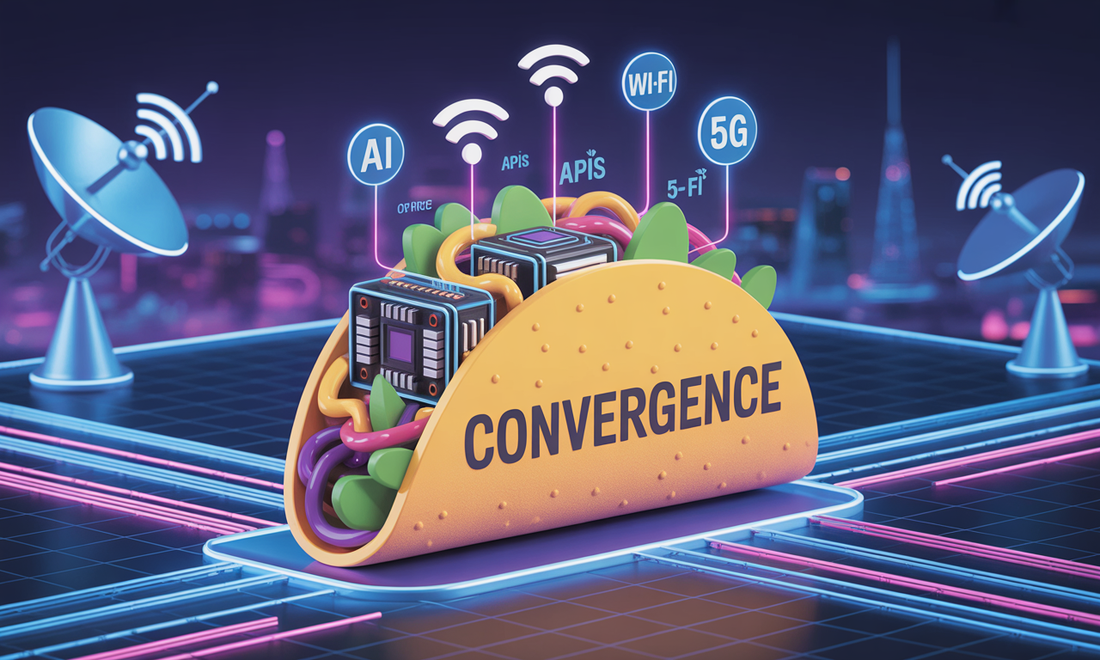The Wireless Global Congress (WGC) and Network X Americas 2025 brought together service providers, vendors, and industry groups in Dallas to address the future of Wi-Fi, convergence, AI, and operational strategy.
I had plenty of Mexican food at the event, including more than a few tacos. Fittingly, the event itself felt like a technology taco, packed with familiar and diverse ingredients: AI, APIs, open-source tools, and more. Convergence was the tortilla holding it all together, giving structure to the ongoing effort to integrate Wi-Fi, cellular, and IoT technologies. What stood out to me most was the strong presence of service providers across the board—from MSOs to MNOs—at the event.
Here's a breakdown of my main insights from the sessions across five focus areas:
1. Convergence: Aligning Wi-Fi and Cellular
Several sessions addressed how Wi-Fi and cellular technologies—especially 5G and upcoming 6G—are expected to work together more closely:
- The goal remains a seamless handoff between Wi-Fi and cellular networks, with no user disruption. This is not a new idea; vendors claiming to solve the problem have come and gone.
- Intel and the WBA promote frameworks where devices automatically connect to the best available network using real-time context and quality metrics.
- Standards work on technologies like OpenRoaming and multi-access identity integration is progressing, but vendor coordination remains challenging.
2. AI & Machine Learning in Network Operations
Everybody needs an AI strategy or at least an AI pitch to remain relevant. AI is now core to how operators monitor, maintain, and optimize their networks:
- Comcast’s AI platform “Octave” analyzes data from 50+ million devices to adjust performance every 20 minutes.
- Over 75% of network alarms are resolved automatically through self-healing AI routines.
- For many operators present, AI also supports customer service tools that assist agents in resolving problems faster and with more accurate information. Yes, and I hate chatbots, too.
Equipment vendors are still keeping their AI engines close to their chests to support their differentiation, and not wanting to create a combined AI engine will limit the value of AI/ML.

3. APIs: Standardized Interfaces for Interoperability and Control
APIs were discussed as a critical infrastructure for enabling cross-vendor integration, especially in operator- and enterprise-managed networks.
- Data sharing APIs allow access points, gateways, and analytics platforms to exchange session quality metrics and usage data, supporting AI and offload decisions.
- The WBA and Wi-Fi Alliance are exploring standardized APIs for provisioning, telemetry, and real-time policy enforcement. These interfaces aim to bridge the gap between disparate vendor equipment and enable faster integration into BSS/OSS systems.
- Several speakers emphasized the need for open APIs to support third-party services (e.g., remote diagnostics, IoT management, or security functions) in managed Wi-Fi deployments.
- In the MNO world, use cases for open APIs remain dominated by network optimization and fraud prevention.
APIs are not a silver bullet—deep integration between systems will still require significant R&D effort. Not all APIs are created equal, and achieving seamless interoperability often demands custom development and coordination. So we are still a long way from a thriving MNO app marketplace.
4. Wi-Fi Offload and Traffic Management
With mobile users relying heavily on Wi-Fi, operators are refining how and when they offload traffic from cellular to Wi-Fi:
- Comcast reports that 90% of mobile usage occurs over Wi-Fi. Their system evaluates Wi-Fi session quality and uses machine learning to prevent bad handoffs.
- WBA is working on access network metrics that allow operators to block the use of known low-performing access points for offload.
The focus has shifted from simple cost savings to delivering a reliable user experience across Wi-Fi and cellular.
5. The Mobile Operators
Mobile operators’ presentations, particularly AT&T’s, highlighted how MNOs are undergoing a major transformation. Network modernization efforts now go beyond traditional upgrades. Central to AT&T's strategy is a shift toward cloud-native, disaggregated, and open RAN architectures, to run 70% of mobile traffic over open interfaces by 2026.
MNOs also embrace converged infrastructure, treat fiber and wireless as part of the same platform, and invest in network APIs to open new monetization models. Their API-first approach aims to support internal product integration, external partnerships with open-access providers, and third-party developer ecosystems, paving the way for innovations in IoT, fraud detection, and more.
Key Challenges Ahead
Despite the momentum, several technical and operational hurdles remain for MNOs:
- Vendor interoperability: Different vendors supply different components of the network. Ensuring these systems work together seamlessly requires extensive testing, integration work, and coordination.
- Cloud and edge deployment: Moving network functions to the cloud and closer to the user improves performance but demands investment in edge compute and real-time system monitoring, which is slow and expensive.
Developer ecosystem enablement: APIs only deliver value if external developers understand how to use them, trust the system, and see a clear business case, which is not the case yet.
- Internal alignment: Large organizations must ensure all business units and teams adopt the same tools, APIs, and infrastructure—no small task at this scale.
Conclusion
There was a bit for everyone attending the event, from Open RAN to Wi-Fi deployment in healthcare, so it is hard to summarize trends among so many verticals and technologies. The industry is progressing on convergence, automation, and user-focused services. But as with any well-stuffed taco, there’s a limit. Add too many ingredients—too many standards, overlapping tools, complex APIs, and proprietary systems—and you risk operational heartburn.
For more blogs, subscribe to our weekly newsletter
